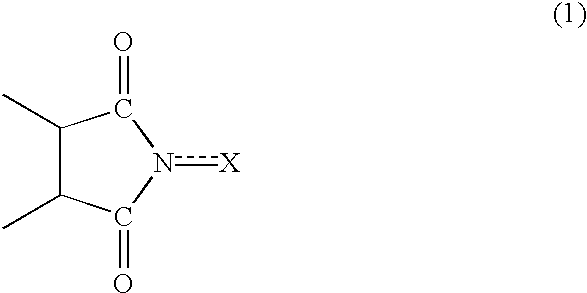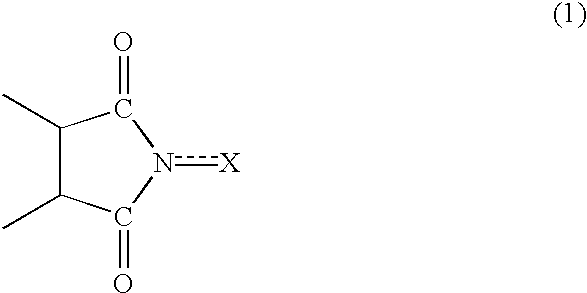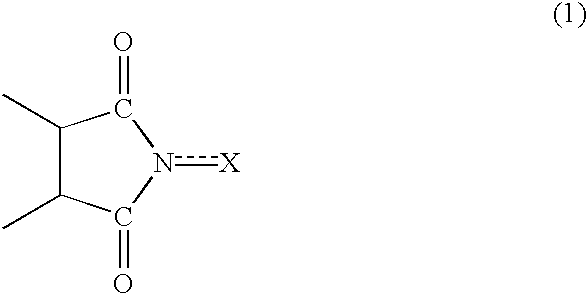Method of separating imide compound
a compound and imide technology, applied in the field of separation methods of imide compounds, can solve the problems of difficult to efficiently separate the reaction product and the non-water-soluble catalyst, the difficulty of separating the water-soluble product from the aqueous phase depending, and the difficulty of oxidation catalyst and the metal catalyst, so as to achieve efficient separation and efficient separation
- Summary
- Abstract
- Description
- Claims
- Application Information
AI Technical Summary
Benefits of technology
Problems solved by technology
Method used
Image
Examples
example a1-1
[0290] To an autoclave (volume 1L) made of titanium and equipped with a condenser and a pressure-controller, were added 50 g (0.594 mol) of cyclohexane, 9.692 g (0.059 mol) of N-hydroxyphthalimide, 0.296 g (0.0012 mol) of cobalt acetate (II) tetrahydrate and 400 g of acetonitrile, and heated to elevate a temperature under applied nitrogen-pressure (33 kgf / cm.sup.2; 3.24 MPa) with stirring. At a temperature of 75.degree. C. was steadied, and a reaction was conducted for 4 hours under applied pressure (40 kgf / cm.sup.2; 3.92 MPa) with flowing air. The system was substituted with nitrogen to be cooled.
[0291] The reaction mixture was analyzed by gas chromatography and high performance liquid chromatography, and, as a result, the conversion of cyclohexane was 19.5%, is cyclohexanone and cyclohexanol were formed in yield 14.5% (selectivity 74.4%) and yield 1.6% (selectivity 8.2%), respectively. Moreover, in the reaction mixture, 9.080 g of N-hydroxyphthalimide used as a catalyst, 0.109 g ...
example a1-2
[0293] A mixture of 25 g (164 mmol) of adamantanol, 5.36 g (32.8 mmol) of N-hydroxyphthalimide, 0.11 g (0.328 mmol) of vanadiumacetylacetonato [V(acac).sub.3], 150 mL of acetic acid and 150 mL of chlorobenzene was stirred for 20 hours at 85.degree. C. and 1 atm (0.101 MPa) in an atmosphere of oxygen. After completion of reaction, the reaction mixture was analyzed by gas chromatography and high performance liquid chromatography, and, as a result, the conversion of adamantanol was 95.6%, adamantandiol and adamantantriol were formed in yield 50.5% (selectivity 52.8%) and yield 40.7% (selectivity 42.6%), respectively. Moreover, in the reaction mixture, 1.85 g of N-hydroxyphthalimide used as a catalyst, 1.51 g of phthalimide, and 0.40 g of phthalic anhydride were contained.
[0294] The reaction mixture was condensed, 1.2 L of water was added thereto, and the mixture was stirred for 2 hours at 50.degree. C. After cooling, an insoluble material was filtrated to recover the catalyst and the d...
example a1-3
[0295] A mixture of 27 g (200 mmol) of adamantane, 3.25 g (20 mmol) of N-hydroxyphthalimide, 0.183 g (0.1 mmol) of V.sub.2O.sub.5, 240 mL of anisol and 60 mL of acetic acid was stirred for 3 hours at 85.degree. C. and 1 atm (0.101 MPa) in an atmosphere of oxygen. After completion of reaction, the reaction mixture was analyzed by gas chromatography and high performance liquid chromatography, and, as a result, the conversion of adamantane was 13.0%, adamantanol and adamantanone were formed in yield 11.3% (selectivity 86.9%) and yield 0.9% (selectivity 6.9%), respectively. Moreover, in the reaction mixture, 2.12 g of N-hydroxyphthalimide used as a catalyst, 0.68 g of phthalimide, and 0.18 g of phthalic anhydride were contained. The reaction mixture was condensed, 400 mL of hexane was added thereto, and the mixture was stirred for 2 hours at 50.degree. C. After cooling, an insoluble material was filtrated to recover the catalyst and the decomposed product thereof in the form of solid. T...
PUM
| Property | Measurement | Unit |
|---|---|---|
| temperature | aaaaa | aaaaa |
| temperature | aaaaa | aaaaa |
| temperature | aaaaa | aaaaa |
Abstract
Description
Claims
Application Information
 Login to View More
Login to View More - R&D
- Intellectual Property
- Life Sciences
- Materials
- Tech Scout
- Unparalleled Data Quality
- Higher Quality Content
- 60% Fewer Hallucinations
Browse by: Latest US Patents, China's latest patents, Technical Efficacy Thesaurus, Application Domain, Technology Topic, Popular Technical Reports.
© 2025 PatSnap. All rights reserved.Legal|Privacy policy|Modern Slavery Act Transparency Statement|Sitemap|About US| Contact US: help@patsnap.com



